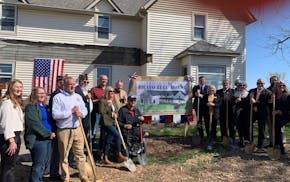Apple Valley resident Celia Scheel is one of hundreds throughout the state who have built colorful rainwater gardens in their yards not only to beautify their property, but to clean up polluted storm water.
Oh, and they also kill mosquito eggs.
Scheel, who has tended plants for more than 20 years and will soon be a certified master gardener, credits guidance offered at a workshop for her garden's design.
More and more communities are touting the rain gardens as a simple way to stop storm-water runoff from polluting Minnesota's lakes and rivers and eroding shorelines because the gardens hold water long enough to filter it before it ends up in bodies of water. It's an important consideration as the steady march of development blankets the land with patios, mall parking lots and new roads, which prevent rainwater from being filtered.
Free workshops on the gardens are scheduled in coming weeks throughout the south metro area.
Experts say a well-designed rain garden can hold water for 48 hours, allowing it to infiltrate soil. That gives plants more nutrients, protects lakes and recharges water tables. At the same time, the design allows the garden to dry up before any mosquito eggs laid in the wet gardens can hatch.
In Inver Grove Heights, progressive leaders are so gung-ho on the approach that they're requiring developers to use rain gardens or other tools that filter storm water.
Burnsville, which has more than three dozen of them, has given $1,000 grants to some residents to construct them. And, for a study, the city paid for the construction of 17 in a 20-year-old neighborhood.
That study looked at the volume of water either going over the land or soaking in through the rain gardens. It found that the first inch of water was the dirtiest, and that was what was captured in the gardens for filtering, said Daryl Jacobson, a Burnsville water resources specialist.
In 2002, he said, city workers and Minneapolis-based Barr Engineering Co. had chosen two nearly identical neighborhoods to study, and monitoring began in those watersheds. The gardens were installed in 2004 in the Rushmore Drive neighborhood, with 17 out of 25 households volunteering for the study. The other neighborhood served as a control site. The results came in 2006, showing a dramatic reduction of storm water flowing into Crystal Lake, he said.
After one year of monitoring, the study found an 82 percent reduction in runoff volume, but for the two years of monitoring after they were installed the number was 90 percent, Jacobson said.
"The project confirms that existing residential neighborhoods ... can be successfully retrofitted with rainwater gardens and provide very high levels of runoff reduction and storm-water quality improvement," he said.
"A lot of people write off rain gardens as just being pretty," said Angela Hanson, a natural resources specialist for Burnsville, "but when people see that they collect the dirty storm water that runs to the lake in their back yard, then they really change their mind about their importance."
The study was accomplished with a $117,000 grant from the Metropolitan Council and $30,000 from the city.
Burnsville leads the way
Eleanor Burkett, extension educator in water resource management at the University of Minnesota, said other communities that are considering rain gardens look to the Burnsville study.
"It gets quoted on every PowerPoint there is," she said.
Mike Isensee, an urban conservationist with the Dakota County Soil and Water Conservation District, said the gardens can improve wildlife habitats, too. Turtles and frogs gather in shoreline gardens. Butterflies, damselflies and dragonflies flit among the native plants. As for the more undesirable buzzing creatures, Isensee said, "We like to say that our rain gardens are actually mosquito death traps."
He said instructors from Blue Thumb workshops help participants through every phase of garden design to make sure it will collect and drain the water properly. Workshops hosted by Isensee's group drew 332 participants last year, including Scheel.
Experts helped her plot her garden location and choose plants, and they even visited her back yard to give advice. It took her about six weeks and $900 to finish her 300-square-foot garden with its liatris, cardinal flowers, goldenrod, ox-eye daisies and shredded hardwood mulch that won't wash away. The garden took longer to plant and was more expensive than others, she said, because rain delayed the work and she had to bust through compacted rock.
"It's a fabulous way," Scheel said, "to help maintain our natural resources, improve our water quality and demonstrate and get back to the way things were a long time ago with all the native plants."
Joy Powell • 952-882-9017 Katie Humphrey • 952-882-9056
Protesters briefly clash at dual pro-Israel, pro-Palestinian rallies at the University of Minnesota

Defense attorneys in Feeding Our Future trial cast doubt on FBI's meal fraud investigation

Overdose deaths spike after incarceration, but Minnesota jails lack treatment
